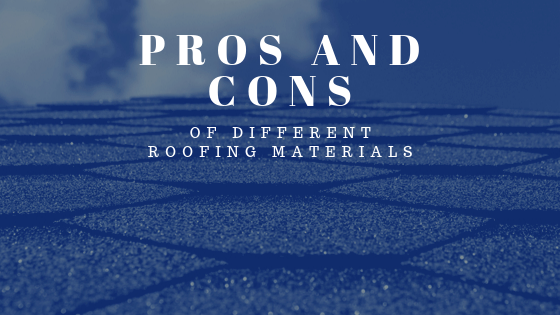Pros and Cons of Different Roofing Materials

A roof is the top covering of a building, including all the materials and constructions necessary to support it is on walls of the building or on the uprights. It provides protection against weather such as rain, snow, sunlight, wind and even extreme temperature. A roof is an essential part of the building envelope.
A roof serves several functions such as:
Drainage
The primary job of the roof is to keep water out of the building or house. The large area of the roof repels a lot of water, which has to be directed in a suitable way. If not, then the building might suffer some damage or inconvenience.
The water repelled by the roof has damaging potential to the building that the roof protects. If it runs down the walls, it may seep into the mortar or through the panels. If it lies around the foundations, it may cause seepage to the interior, rising dry or dry rot.
The rule of thumb, in general, is the pitch of the roof has to be proportional to the amount of precipitation. House in area of low rainfall frequently has a roof with a low pitch while those in the high area of rainfall and snow have a steep roof.
Insulation
The insulation of the roof is always a consideration in its structure and the choice of roofing material. Some of the material, particularly those of natural fibrous material such as thatch have excellent insulation properties. For those that do not, extra insulation is always installed under the outer layer.
In developing countries, the majority of the house has a ceiling installed under its structural members of the roof. The purpose is to insulate against the hot and the cold, noise, dirt, and often droppings from bird or mouse who frequently choose roof as its nesting place.
The type of material that is used for the roof of the building of the house will determine the longevity and the durability of the building itself. Below is the list of most common materials that are used as roof and its pro and cons:
Tile roof
Tile roof is beautiful and durable. They are also expensive and heavy, but that is because it is expected to last longer.
Traditionally, roof tiles are made of fired clay or terra cotta product. In modern times, roofing tiles often made of molded, tinted concrete.
Roofing tiles come in various of shapes; curved, flat, fluted or interlock and many others. Tile roof is a great choice for houses or building that is located in a hot weather area or has high exposure to salt air.
Tile roof is also impervious to rot and insect damage, unlike woods that can decay over time. It is environmentally friendly material, as they are made of earth minerals and not chemicals. More often than not they can be pulverized and recycled when they are removed. Tile roof helps regulate indoor temperatures.
However, because of its heavyweight in order to install and use this material a lot of roofing contractors will be needed. The tiles have to be measured and lied in a specific pattern so that no moisture can seep through. This tends to invite a high cost.
Metal Roofing
Metal roofing is one of the alternative material next to the tile roof. It is extremely durable and can easily survive wind storms, snow, and rainwater. It has the same properties as tiles roofing, it tends to be resistant to mildew, insect infestation, and rot. Metal roofs are also lightweight compared to tiles roofs. They are easy to be installed. Metal roofs are non-combustible, however, if there is any existing roof underneath it, it may affect its fire resistance properties.
However, a metal roof can be expensive. Dependable on the building or the house location, if located in a place that has a huge amount of rainfall, it can be very noisy. The noise can be minimized using materials that utilize structural barriers that reduce the drumming effect by applying them over insulation or solid plywood sheathing. It is difficult to walk through since organic material can create a slippy surface to walk on.
Asphalt Roll Roof
Asphalt roll roof is made from large rolls of the same material used in asphalt shingles. It is used for relatively flat pitches such as the angled shelf roof. It is installed by laying strips lengthwise across the roof in overlapping courses. It lasted for 5 to 10 years on average. They are affordable and effective. It is easy to install them and they come in a lot of variety of colour and styles which make people feel comfortable in using them as a decorative purpose as well.
However, if the building or house is located in a hot climatic place, it is advisable not to use them. Hot weather will cause asphalt roll roof to expand and contract which will end with it cracking and colour fading. If installed below freezing temperatures, they can get damaged as well.
Wood Shingle roof
A wood shingle roof is made of thin, wedge-shaped pieces of natural wood such as cheddar and yellow pine which are sawn from logs. They make a very attractive roof. However, they are very tricky to install and will need professionals to install them. Wood shingle roof reaches an average of twenty to thirty years of longevity through longer lifespans are achieved in the location where the roof experiences mild conditions and remains free of debris. If it is maintained well, it can reach up to fifty years.
Wood Shingles, however, are much more expensive compared to asphalt shingles.
They are fire hazard material, hence it is not wise to use them in the area in which there are seasonal fire hazards. They are also prone to termites and rot, hence their upkeep is much more continuous rather than roofs from other material.

In Awe Roofing Limited is an Award-Winning, family owned and operated Vancouver Roofing Contractor with over 17 years of roofing experience. We serve the entire Lower Mainland area, from Whistler to Chilliwack, employing a team of professional staff members. Our team has won numerous awards including Best of Homestars for the last five years, and Three Best Rated six years in a row. Learn more






















